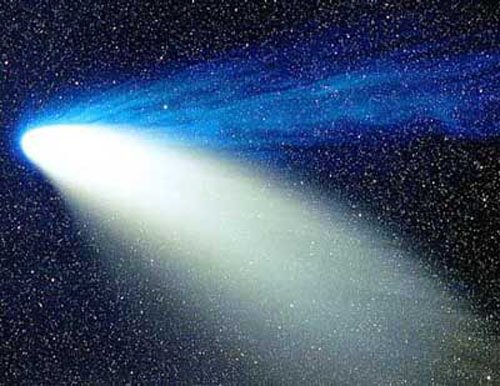Comets and Asteroids; How they fit in our solar system
Asteroids and Comets
Asteroids
Asteroids are what scientists call "rocks in space" that orbit the sun. However, asteroids are more than just random rocks floating in the vacuum of space. They can be as mall as a pebble or the size of your house! They're sometimes leftover material from the formation of our planets or they can be material that was ejected after a collision between two large celestial bodies. Most of the asteroids in our solar system are located in the area of space between Mars and Jupiter. Simply known as the "asteroid belt." The belt is "estimated to contain 1.1 between 1.9 million asteroids larger than 1 kilometer in diameter and millions of smaller ones," according to NASA.
citation
Asteroids are pretty big, so it would make sense for them to cause damage if they were to hit something. Earth has been hit by asteroids in the past. I'm sure everyone has heard of the K-T extinction by now, so I won't bother explaining it. But Earth has been hit by other, much smaller asteroids in the past. Imagine throwing a rock on the beach. That rock lands and when you go to pick it up it has made a small indentation in the sand- a crater. Meteors leave craters because of how fast they are going when they hit the ground. Most meteoroids don't even make it to the Earth's surface because they burn up in the upper atmosphere. But the meteoroids that do make it past the Earth's upper atmosphere are re-classed as meteors. Craters don't really stick around for to long on Earth because of plate tectonics and erosion. But there are a few craters that you can go and look at right now! One awesome crater is Meteor Crater in Arizona

source
Comets
I'm sure that most of the people reading this are already aware of the asteroid belt and what asteroids are. So, now I will discuss the dirty snowballs of our solar system; comets. To most people comets look like large glowing balls of light in the night sky with a large tail behind it, and that's kinda right. However, a comet is really a large body made of frozen volatiles such as methane, ammonia and water to name a few. They have long elliptical orbits and the reason they have their long tails is because when they approach the sun, the heat from the sun starts melting the ice on the comet. The melting of the ice is what creates the comet's glorious tail and glow. Comets come from a belt that's separate from the asteroid belt. The trans-neptunian Kuiper Belt. The Kuiper belt is located 50 AU from our sun (AU=astronomical unit, the distance from the Earth to the sun). The Kuiper belt is where all the comets in our solar system hang out. The Kuiper belt is also far larger than the asteroid belt and 20 - 200 times as massive.

source
Comets tend to be a lot bigger than asteroids simply because the ices that have accumulated on their surfaces continue to do so until they approach the sun and the ice begins to melt away. If a comet were to hit Earth it would be pretty devastating. Depending on it's size the comet could wipe out a continent or all life on Earth. The extinction of the dinosaurs made this clearly evident.
Lucky for us though we have a massive gas giant, 2 times more massive than every other planet combined. Jupiter is kind of like our cosmic janitor, collecting and sometimes absorbing the dirty snowballs that would otherwise come barreling towards Earth. Astronomers actually witnessed a comet impacting Jupiter in 1994. The comet, named Shoemaker-Levy9 had broken up 2 years earlier and in '94 was obliterated by Jupiter's immense gravitational pull. The scars that were left in Jupiter's cloud layer dissipated a few months afterword. But scientists and astronomers were able to capture some of the impact using infrared telescopes.

source
Comets and asteroids are still a large focus for astronomers right now, since there is always the chance that one could be on a collision course with this little blue ball that we call home.
Author's Words
Hey everyone! This was my first steemit post and I just want to let everyone know that I will most likely keep with the subject in space in most of, if not all of my posts. I want you to share your thoughts on this post please!!! I appreciate any and all constructive criticism.
Citations
Thumbnail
NASA Statement
Meteor Crater
Kuiper Belt
Shoemaker-Levy9 infrared image

That's a very nice post. I remember a moment in the planetarium of the Academy of Science in San Francisco where I made a trip through the solar system (I recommend this pace btw, although it is slightly expensive).
Very nice post, its always nice to get to learn new things about space! You put together a nice presentation of information about asteroids comets and their differences! Great job, keep it up!
Congratulations @eliwood! You have received a personal award!
Click on the badge to view your own Board of Honor on SteemitBoard.
For more information about this award, click here
Congratulations @eliwood! You have received a personal award!
Click on the badge to view your Board of Honor.
Do not miss the last post from @steemitboard:
Congratulations @eliwood! You received a personal award!
You can view your badges on your Steem Board and compare to others on the Steem Ranking
Do not miss the last post from @steemitboard:
Vote for @Steemitboard as a witness to get one more award and increased upvotes!